Balkinization
an unanticipated consequence of
Jack M. Balkin
Balkinization Symposiums: A Continuing List
E-mail:
Jack Balkin:
jackbalkin at yahoo.com
Bruce Ackerman
bruce.ackerman at yale.edu
Ian Ayres
ian.ayres at yale.edu
Corey Brettschneider
corey_brettschneider at brown.edu
Mary Dudziak
mary.l.dudziak at emory.edu
Joey Fishkin
joey.fishkin at gmail.com
Heather Gerken heather.gerken at yale.edu
Abbe Gluck abbe.gluck at yale.edu
Mark Graber
mgraber at law.umaryland.edu
Stephen Griffin
sgriffin at tulane.edu
Jonathan Hafetz
jonathan.hafetz at shu.edu
Jeremy Kessler
jkessler at law.columbia.edu
Andrew Koppelman
akoppelman at law.northwestern.edu
Marty Lederman
msl46 at law.georgetown.edu
Sanford Levinson
slevinson at law.utexas.edu
David Luban
david.luban at gmail.com
Gerard Magliocca
gmaglioc at iupui.edu
Jason Mazzone
mazzonej at illinois.edu
Linda McClain
lmcclain at bu.edu
John Mikhail
mikhail at law.georgetown.edu
Frank Pasquale
pasquale.frank at gmail.com
Nate Persily
npersily at gmail.com
Michael Stokes Paulsen
michaelstokespaulsen at gmail.com
Deborah Pearlstein
dpearlst at yu.edu
Rick Pildes
rick.pildes at nyu.edu
David Pozen
dpozen at law.columbia.edu
Richard Primus
raprimus at umich.edu
K. Sabeel Rahmansabeel.rahman at brooklaw.edu
Alice Ristroph
alice.ristroph at shu.edu
Neil Siegel
siegel at law.duke.edu
David Super
david.super at law.georgetown.edu
Brian Tamanaha
btamanaha at wulaw.wustl.edu
Nelson Tebbe
nelson.tebbe at brooklaw.edu
Mark Tushnet
mtushnet at law.harvard.edu
Adam Winkler
winkler at ucla.edu
Compendium of posts on Hobby Lobby and related cases
The Anti-Torture Memos: Balkinization Posts on Torture, Interrogation, Detention, War Powers, and OLC
The Anti-Torture Memos (arranged by topic)
Recent Posts
The Antebellum Civil Rights Movement And The Antislavery Background Of The Fourteenth Amendment
Just A Few Blogs
ACS Blog
Alas, a Blog
Althouse
Arts and Letters Daily
Atrios (Eschaton)
Bill of Health
Buzzflash.com
Buzz Machine
Cato at Liberty
Juan Cole (Informed Comment)
Concurring Opinions
The Constitution in 2020
Corrente
Crooked Timber
Daily Howler
Daily Kos
Dana Boyd
Brad DeLong
Digby (Hullabaloo)
Discriminations
Daniel Drezner
Kevin Drum (Mother Jones)
Electrolite
En Banc
Eunomia (Daniel Larison)
Fafblog
Michael Froomkin (Discourse.net)
GovLab (Beth Noveck)
Rick Hasen (Election Law)
History News Network
How Appealing
Ignatz (Sam Heldman)
The Importance of (Ernie Miller)
Infolaw
Instapundit
International Economic Law and Policy Blog
IntLawGrrls
Jacob Levy
Jesus' General
Jurisdynamics
The Kitchen Cabinet
Mark Kleiman
Law Blog Central
Larry Lessig
Lawyers, Guns and Money
Liberal Oasis
Brian Leiter's Law School Reports
The Leiter Reports
Marginal Revolution
Megan McArdle
Memeorandum
Metafilter
Mirror of Justice
The New Republic
Newseum
No More Mister Nice Blog
Brendan Nyhan
Opinio Juris
Orcinus
The Originalism Blog
Pandagon
Passport (Foreign Policy)
Overcoming Bias
Political Animal (Washington Monthly)
Political Theory Daily Review
Political Wire (Taegan Goddard)
The Poor Man
Virginia Postrel
Prawfsblawg
Public Reason
Jonathan Rauch
Raw Story
Redstate
ReligiousLeftLaw.com
Reporters Committee For Freedom of the Press
Reproductive Rights Blog
Rothman's Roadmap to the Right of Publicity
SCOTUS Blog
Seeing the Forest
Clay Shirky
The Shifted Librarian
The Situationist
Larry Solum (Legal Theory)
Andrew Sullivan
Talking Points Memo
Talk Left
Tapped
Tbogg
TechPresident
The Paper Chase (Jurist)
Tom Paine
Tom Tomorrow (This Modern World)
Eve Tushnet
Uggabugga
University of Chicago Law School Faculty Blog
Unqualified Offerings
The Volokh Conspiracy
War and Piece (Laura Rozen)
Wampum
Oliver Willis
Wonkette
Written Description
Matthew Yglesias
Yin
Your Choice of Feeds
1. XML
powered by
2. Atom Feed
3. RSS 2.0
The Antebellum Civil Rights Movement And The Antislavery Background Of The Fourteenth Amendment
Guest Blogger
For the Symposium on Kate Masur, Until Justice Be Done: America's First Civil Rights Movement, From the Revolution to Reconstruction (W. W. Norton & Company, 2021). Michael Les Benedict Kate Masur’s Until
Justice Be Done is a major contribution to the history of the conflict over
rights in the United States. It will be
the standard account of African American’s struggle for equal rights from the
turn of the nineteenth century through the ratification of the Reconstruction-era
amendments to the Constitution. As such, it provides a new perspective on the origins of
the Civil War constitutional amendments and the intention of the American
people in framing and ratifying them. Masur’s account deepens historians’ understanding of the
antislavery movement in several very significant ways. First, Masur gives us a new account of
the origins of the Civil War-era constitutional amendments. The classic view has been that there were antislavery
origins to those amendments. The great works
that recovered those origins were titled The Antislavery Origins of the
Fourteenth Amendment and “The Early Antislavery Backgrounds of the
Fourteenth Amendment.”[1] Both harkened back to abolitionist arguments
articulated by white abolitionists like Alvan Stewart, William Goodell, and
Lysander Spooner that slavery itself was unconstitutional and
unconstitutionally deprived Americans of the rights to free speech, free press,
petition, assembly, and due process of law.
William Wiecek’s classic The Sources of Antislavery Constitutionalism
in America likewise attended only to the white abolitionists who developed
the antislavery constitutional argument.[2] Frederick Douglass rated one mention, as
newspaper editor rather than theorist. The
natural conclusion one draws after reading Until Justice Be Done is that
the origins of the Fourteenth and Fifteen Amendments lie not so much in
antislavery constitutionalism but in what she calls “the first civil rights
movement”—the black-led movement for equal rights that ran from the Revolution
through the Civil War and into Reconstruction
(I prefer “equal rights” to “civil rights” as a descriptor of the
movement Masur chronicles). This leads to Masur’s
second contribution. Masur implicitly
but clearly distinguishes between the antislavery movement per se and
the movement for equal rights. This
insight is one of those jaw-dropping ones that makes apparent what had been
implicit in recent studies of antebellum black activism. Until now, historians have conceived of the
great crisis of the mid-nineteenth century in terms of the antislavery
movement. Most of the historiography has
concentrated on abolitionism. We have
numerous accounts of the Garrisonians. For
a long time they were credited with creating the intellectual, moral, and
political environment in which Northerners finally confronted slavery. The Garrisonians famously eschewed politics in
favor of “moral suasion” in their campaign against slavery, bitterly condemning
the “political abolitionists” who disagreed with their approach. Historians
have begun to argue that it was the political abolitionists rather than the
Garrisonians, who brought slavery to an end.
All these accounts treat calls for equal rights as an element of the
antislavery campaign, with the Garrisonians especially committed and political
abolitionists more ambivalent. In recent years
scholars have chronicled the work of black activists, stressing their quest for
recognition as citizens, their demand to be considered Americans rather than
outsiders.[3] But Masur’s is the first synthetic account,
and the first to conceive of these activities as a civil rights movement
complementing but separate from the antislavery movement. While the campaign against slavery and the
campaign against racially discriminatory laws were related, they were not the
same thing. The distinction was
illustrated most clearly in 1865, when Garrison successfully called upon the
American Anti-Slavery Society to disband and discontinued The Liberator,
while his old co-agitator Wendell Phillips insisted that the struggle would not
be over until black Americans had equal rights. I had never understood how Garrison could be
so obtuse until I read Masur’s work. Now
I understand that for Garrison, the issue was slavery not equal rights. He sympathized with equal rights for
everybody, and the Anti-Slavery Society took a firm stand for equal rights not
only for blacks but for women. Garrisonians
regularly called for equality of rights for freed people among their
resolutions condemning slavery. But the
issue was slavery. Equal Rights was ancillary.
Get rid of slavery, and equal rights
would follow. That was not the view of
the black leaders of the civil rights movement.
They were contesting racially discriminatory laws in the North. Garrison might think that these would
dissolve once they no longer were needed to buttress slavery. Black northerners knew better. Although white
abolitionists sympathized, it was black northerners who drove the campaign for equal
rights. Whites dominated the antislavery
movement, with black northerners giving important and often crucial
support. (African Americans accounted
for three-quarters of the subscribers to The Liberator, for
example.) A few black Americans, most
famously Frederick Douglass, were leaders in both movements. But Masur’s work indicates that we will
understand developments better if we conceive of the two movements separately
rather than as one. It is appropriate
for historians to speak of abolitionists and their black allies. In describing he civil rights movement, Masur
speaks of African Americans and “their white allies.” There is a logic to this. The black movement for equal rights was aimed
at discrimination in the North more than at slavery in the South. It grew explosively in the 1840s and 1850s after
black northerners initiated the black convention movement. These conventions represented, as their
titles demonstrated, the “colored citizens” of the northern states in which
they were called.[4]
Their resolutions and addresses to white
northerners complained about the humiliating legal discrimination they faced. Of course, there would be a resolution or two
denouncing slavery, but the focus was on equal rights in the North. The
national conventions were called by the state conventions and reflected their
concentration on securing equal rights in the states. The Thirteenth Amendment was the culmination
of the white-led antislavery movement.
The Fourteenth and Fifteenth Amendments were the culmination of the black-led
equal rights movement. Within this framework, Masur recovers
black voices to a degree unprecedented in Civil War-era historiography, her
third contribution. The classic studies
of American abolitionism reproduced the white voices of the movement.[5] Historians have acknowledged the important
role blacks played in supporting the movement, but until quite recently only
Douglass has received much attention. There
is a good reason for this concentration on the white voice. Most abolitionists were white, and so were
their theorists and propagandists.
Abolitionists were concerned with the suffering of black slaves but much
of their concern centered on the sin of slavery, and how white northerners as
well as southerners were implicated in that sin. Political abolitionists stressed especially
the ways that slaveowner control of the federal government—the so-called “slave
power”—infringed the liberties of white northerners. Most historians see concern for the rights of
white northerners as more important than concern for the rights of blacks in
the growth of antislavery sentiment in the North. Masur discusses at length the way Black
Seaman laws affected black mariners, for example. Antislavery whites stressed the way South
Carolina deprived white Massachusetts lawyer Samuel Hoar of the right to
challenge the laws in court. Masur misses an
important opportunity to illustrate how the black-led equal rights movement
intersected and informed the white-led antislavery movement. She pays scant attention to the effect enforcement
of the Fugitive Slave Act of 1850 had on white northerners, saying only that it
“radicalized” some of them. She says
surprisingly little about it enabled the black leadership of the equal rights
movement to attract white support. Blacks
resisted the enforcement of the law throughout the North, often with violent
attacks on slavecatchers and even on federal officers aiding them. They justified these efforts to rescue
alleged fugitives by pointing out, accurately, that they would have no
opportunity to prove their freedom in proceedings before fugitive slave
commissioners, much less if slave catchers simply dragged them South with no
proceedings at all. In the most northern
tier of states, whites overwhelmingly backed the rescues. In the middle tier, there were bitter
divisions among whites. Whites condemned
black resistance only along the border with the South, and even there a good
number of whites dissented. Historians have long
known that the enactment of the Fugitive Slave Act backfired upon proslavery
southerners, by sparking northern resistance and new personal liberty
laws. The events have been seen as part
of the antislavery story, however, and not as part of the equal rights
story. Masur’s recovery of an equal
rights movement related to but separate from the antislavery movement,
encourages us to see the northern reaction in a different light: the Fugitive Slave Act sensitized antislavery
advocates who had concentrated primarily on northern white grievances to the issue
of black rights. It was the point where
the two movements converged. In the
words of John Brooke, people discovered that “There Is a North,” and
identified it not only with free soil for whites but personal rights for
blacks.[6] Another of Masur’s
important contributions is that racially discriminatory laws related to the
Poor Laws that were part of the common-law heritage of the United States. The law had long recognized the right of
local governments to restrict poor relief to members of the community. Denial of poor relief to African Americans, like
laws and constitutional provisions that banned their immigration, signaled their
exclusion from the community. The
policies were buttressed by the legal recognition of the right of states and
localities to exercise police powers to protect the community against “moral
contagion.” Nothing dismayed black
Americans more than this denial that they were part of the community. They vehemently and persistently protested
against it. When African Americans
insisted that they were citizens, they meant that they were part of the
community that was trying to exclude them.
Equal rights meant being treated like everyone else in the personal
rights that all members of the community shared. These were basic rights like legal protection
of life, liberty, and property; contract rights; marital rights; parental
rights; and the right to move freely from place to place. The rights of citizenship were something
else. They were the political rights
that belonged to all male citizens. Black
activists claimed these rights as well. Their
denial was also a mark of exclusion from the community, but they were a
different category of rights. Masur does not attend
much to this distinction, if at all, but it is important for understanding how
the definition of citizen’s rights changed during the Civil War and
Reconstruction. The Civil Rights Act of
1866 defined citizenship in a way that included black people born in the United
States and subject to its jurisdiction.
Then it declared that all citizens were entitled to the same basic
rights as white citizens. As Masur
points out, this formulation permitted states to deny basic rights to
foreigners, especially Chinese immigrants, and Indians. The law treated what had been the basic
rights of all as the civil rights of citizens.
Moreover, the law pointedly
omitted any allusion to the political rights of citizens. This formulation was a distinct narrowing of
the meaning of citizenship, which had always been understood as a political
status.[7] Republicans further muddled the conceptions
when they changed the rights language in a law passed in 1870 to enforce the
Fourteenth Amendment. The new language gave all persons the
same basic rights as white citizens. Masur’s stress on the
antebellum equal-rights sources of the Fourteenth Amendment leads to a new
appreciation of how radical even a conservative interpretation of its
provisions was. That is particularly
true of the state-action doctrine the Supreme Court articulated in the Civil
Rights Cases.[8]
The first civil rights movement was aimed at the state and local legislation
that marked African Americans as outsiders.
Its underlying theme was that black Americans were part of the
community. The ultimate aspiration was
complete acceptance, socially as well as in civil and political life. The most symbolic action a community could
take in , that regard was to repeal legislation that barred interracial
marriage. Private behavior was not the
target of the movement Masur describes. No
one proposed to make it illegal to prefer spouses of the same race. The black leaders of the equal-rights
movement aimed at government action, and so did the Reconstruction amendments
that were its culmination. The
accomplishment itself was a momentous change.
That is why Masur’s chief condemnation of later court decisions is that
they sustained racial segregation, not that they limited the enforcement to
state action. Segregation laws were
affirmations of the otherness of black Americans, exactly what the first civil rights
movement condemned. As Justice Harlan
saw, the fact that they restrained both blacks and whites was irrelevant to the
unconstitutional purpose of writing racial distinctions into law. But in other ways, a
too exclusive focus on the first civil rights movement as the foundation for
the Reconstruction amendments leads to too narrow an interpretation of
them. Masur reads the spirit of
inclusion into the Fourteenth Amendment’s Privileges and Immunities Clause. It was “designed to protect individuals
against injustices perpetrated by the states and their agents,” she says
(345). But her account makes clear that from
the perspective of the black-led civil rights movement, it was aimed at a
particular legal manifestation of otherness—the refusal to recognize black
Americans as citizens with the right to enter states and be treated like other
citizens. It is the Equal Protection
Clause that most clearly represents black demands that states stop making
racial distinctions among their own citizens, and the Court has interpreted it
that way since the 1950s. The experience of
white abolitionists provides another related-but-distinct heritage that
informed the Reconstruction amendments. Masur
focuses on black claims. Proslavery
suppression of white rights does not play much of a role in her story. She does not attend to the mobbing of white
abolitionists, the burning of lecture halls that accommodated them, and the
refusal of civil authorities to protect their free-speech, free-press, and
freedom-of-assembly rights. She barely
mentions the murder of antislavery newspaper editor Elijah Lovejoy. She understandably stresses the way
anti-abolitionist mobs turned on black people rather than how local authorities
refused to protect the mostly white abolitionists. The story of the expulsion of Massachusetts
lawyer Samuel F. Hoar from South Carolina is chronicled in terms of the way the
law he intended to challenge affected black mariners and motivated black
activism in New England, not in terms of South Carolina’s refusal to accord a
white citizen of Massachusetts the rights promised by the Constitution’s
Privileges and Immunities Clause.
(South Carolinians could plausibly argue that black citizens of New
England states were not citizens of the United States entitled to the protection
of that clause; they could not say that of Hoar.) The refusal of southern states to protect
northern white abolitionists who wanted to agitate in the South; their demand
that northern legislators suppress abolition societies; the exclusion of abolitionist
materials from southern post offices, efforts to extradite white abolitionists
for inciting slave insurrection, failure to protect southern white abolitionists—none of
these are part of the story she tells about black agitation for equal rights in
the North. This is not a
criticism of Masur’s outstanding and illuminating work. All those violations of rights are part of
the abolition story and have been told by the chroniclers of that
movement.[9] But they are important for understanding the
meaning of the Fourteenth Amendment. For
white abolitionists the right to equal protection of the law did not mean the
right to be subject to nondiscriminatory laws.
For them the key word was not “equal” but “protection.” When they were mobbed, when their lecture
halls were burned, when they were driven from the South, they were denied the
protection that state laws were supposed to afford to all. During Reconstruction, Republicans tried to
provide the protection that the southern states were unwilling or unable to
provide. The Supreme Court refused to
consider the legislation in these terms.
To do so would have required the Court either to defer to Congress’s
judgment that such an intervention was necessary, or to insist on the absence
of state protection as an element of the private conduct to be punished. It should be no surprise that the justices instead
chose to limit Congress’s power to offsetting state-mandated discriminations
and crimes clearly motivated by race.[10] It is doubtful that a fuller
understanding of the Reconstruction constitutional amendments will affect court
decisions. Precedent remains more
important in legal decisions than constitutional historians’ rediscoveries of
original intent. But if there is one
more insight that emerges from Masur’s study, it is that judicial constructions
of constitutional law can be overturned through popular constitutional
politics. Masur’s work is as much part
of the constitutional politics of the present as a recovery of the
constitutional politics of the past. If
the American people decide that the principles that underlay the equal rights
movements of the past must be applied to the American Constitution of today,
they will prevail. Sooner or later, the
decision made through constitutional politics will be reflected in
constitutional law.
[1]
Jacobus TenBroek, The Antislavery Origins of the Fourteenth Amendment
(Berkeley: University of California Press, 1951); Howard Jay Graham, “The Early
Antislavery Backgrounds of the Fourteenth Amendment,” in Graham, Everyman’s
Constitution: Historical Essays on the Fourteenth Amendment, the “Conspiracy
Theory,” and American Constitutionalism (Madison: State Historical Society
of Wisconsin, 1968): 152-241. [2]
William M. Wiecek, The Sources of Antislavery Constitutionalism in America,
1760-1848 (Ithaca, N.Y.: Cornell University Press, 1977). [3] Stephen Kantrowitz, More That Freedom: Fighting
for Black Citizenship in a White Republic, 1829-1889 (N.U.: Pnguin, 2012);
Christopher James Bonner, Remaking the Republic: Black Politics and the
Creation of American Citizenship (Philadelphia: University of Pennsylvania
Press, 2020); Martha S. Jones, Birthright Citizens: A History of Race and
Rights in Antebellum America (N.Y.: Cambridge University Press, 2019); Van Gosse, The First Reconstruction: Black
Politics in America from the Revolution to the Civil War (Chapel Hill:
University of North Carolina Press, 2021). [4]
For example, Minutes of the State Convention of the Colored Citizens of the
State of Michigan, Held in the City of Detroit on the 26th and 27th
of October, 1843 (Detroit: Wm. Harsha, 1843); Minutes of the Fifth
Annual Convention of the Colored Citizens of the State of New York, Held in the
City of Schenectady, on the 18th, 19th, and 20th
of September, 1844 (Troy: J.C. Kneeland and Co., 1844). See the Digital Records of the Colored
Conventions Project (omeka.coloredconventions.org) [5]
Louis Filler, The Crusade Against Slavery;, 1830-1860 (N.Y. Harper &
Row, 1960); Dwight L. Dumond, Antislavery (Ann Arbor: University of Michigan
Press, 1961); Aileen Kraditor, Means and Ends in American Abolitionism: Garrison and His Critics on Strategy and
Tactics, 1834-1850 (N.Y.: Pantheon Books, 1969); Merton Dillon, The
Abolitionists: The Growth of a
Dissenting Minority (DeKalb: Northern Illinois University Press, 1974). [6]
John L. Brooke, “There is a North”: Fugitive Sales, Political Crisis, and
Cultural Transformation in the Coming of the Civil War (Amherst: University
of Massachusetts Press, 2019). [7]
See Michael Les Benedict, “Membership of a Nation, and Nothing More”: The Civil Rights Act of 1866 and the
Narrowing of Citizenship in the Civil War Era,” in “The Greatest and Grandest
Act”: The Civil Rights Act of 1866 from Reconstruction to Today, ed.
Christian Samito (Carbondale: Southern Illinois University Press, 2018), 9-36. [8]
109 U.S. 3 (183). [9]
Leonard L. Richards, Gentlemen of Property and Standing: Anti-Abolition Mobs
in Jacksonian America (N.Y.: Oxford University Press, 1970); Dillon, The
Abolitionists, supra note 6. [10]
Analysts have tended to stress the state-action requirement and to have failed
to see that the justices sustained federal power to punish private actions that
were racially motivated. See Pamela
Brandwein, Rethinking the Judicial Settlement of Reconstruction (N.Y.:
Cambridge University Press, 2011) and Michael Les Benedict, “Preserving
Federalism: Reconstruction in the Waite Court,” Supreme Court Review
1978: 39-80. Michael Les Benedict is Professor Emeritus, History, Ohio State University, and Visiting Scholar, Ohio State University Moritz College of Law. You can reach him by e-mail at benedict.3@osu.edu
Posted
9:30 AM
by Guest Blogger [link]
Books by Balkinization Bloggers

Gerard N. Magliocca, The Actual Art of Governing: Justice Robert H. Jackson's Concurring Opinion in the Steel Seizure Case (Oxford University Press, 2025)

Linda C. McClain and Aziza Ahmed, The Routledge Companion to Gender and COVID-19 (Routledge, 2024)

David Pozen, The Constitution of the War on Drugs (Oxford University Press, 2024)

Jack M. Balkin, Memory and Authority: The Uses of History in Constitutional Interpretation (Yale University Press, 2024)
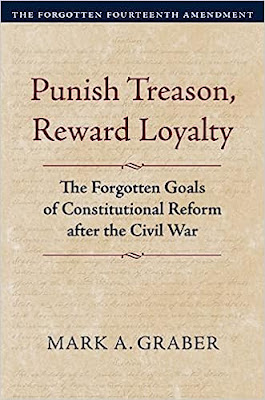
Mark A. Graber, Punish Treason, Reward Loyalty: The Forgotten Goals of Constitutional Reform after the Civil War (University of Kansas Press, 2023)
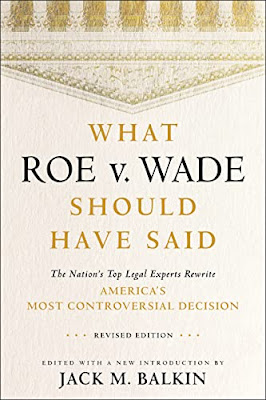
Jack M. Balkin, What Roe v. Wade Should Have Said: The Nation's Top Legal Experts Rewrite America's Most Controversial Decision - Revised Edition (NYU Press, 2023)

Andrew Koppelman, Burning Down the House: How Libertarian Philosophy Was Corrupted by Delusion and Greed (St. Martin’s Press, 2022)

Gerard N. Magliocca, Washington's Heir: The Life of Justice Bushrod Washington (Oxford University Press, 2022)
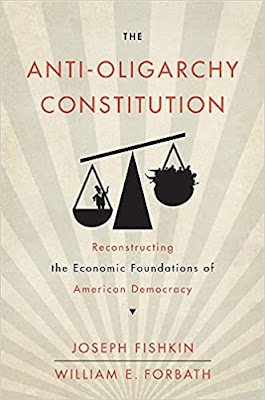
Joseph Fishkin and William E. Forbath, The Anti-Oligarchy Constitution: Reconstructing the Economic Foundations of American Democracy (Harvard University Press, 2022)
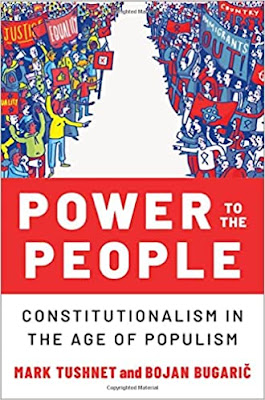
Mark Tushnet and Bojan Bugaric, Power to the People: Constitutionalism in the Age of Populism (Oxford University Press 2021).

Mark Philip Bradley and Mary L. Dudziak, eds., Making the Forever War: Marilyn B. Young on the Culture and Politics of American Militarism Culture and Politics in the Cold War and Beyond (University of Massachusetts Press, 2021).

Jack M. Balkin, What Obergefell v. Hodges Should Have Said: The Nation's Top Legal Experts Rewrite America's Same-Sex Marriage Decision (Yale University Press, 2020)

Frank Pasquale, New Laws of Robotics: Defending Human Expertise in the Age of AI (Belknap Press, 2020)

Jack M. Balkin, The Cycles of Constitutional Time (Oxford University Press, 2020)

Mark Tushnet, Taking Back the Constitution: Activist Judges and the Next Age of American Law (Yale University Press 2020).

Andrew Koppelman, Gay Rights vs. Religious Liberty?: The Unnecessary Conflict (Oxford University Press, 2020)

Ezekiel J Emanuel and Abbe R. Gluck, The Trillion Dollar Revolution: How the Affordable Care Act Transformed Politics, Law, and Health Care in America (PublicAffairs, 2020)

Linda C. McClain, Who's the Bigot?: Learning from Conflicts over Marriage and Civil Rights Law (Oxford University Press, 2020)
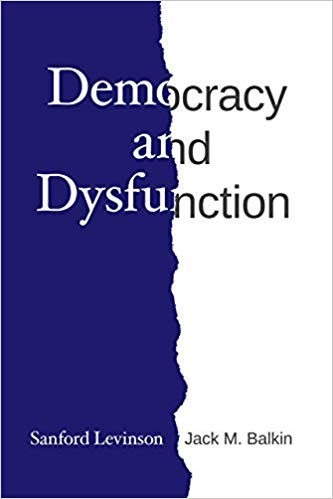
Sanford Levinson and Jack M. Balkin, Democracy and Dysfunction (University of Chicago Press, 2019)

Sanford Levinson, Written in Stone: Public Monuments in Changing Societies (Duke University Press 2018)

Mark A. Graber, Sanford Levinson, and Mark Tushnet, eds., Constitutional Democracy in Crisis? (Oxford University Press 2018)

Gerard Magliocca, The Heart of the Constitution: How the Bill of Rights became the Bill of Rights (Oxford University Press, 2018)

Cynthia Levinson and Sanford Levinson, Fault Lines in the Constitution: The Framers, Their Fights, and the Flaws that Affect Us Today (Peachtree Publishers, 2017)

Brian Z. Tamanaha, A Realistic Theory of Law (Cambridge University Press 2017)

Sanford Levinson, Nullification and Secession in Modern Constitutional Thought (University Press of Kansas 2016)

Sanford Levinson, An Argument Open to All: Reading The Federalist in the 21st Century (Yale University Press 2015)

Stephen M. Griffin, Broken Trust: Dysfunctional Government and Constitutional Reform (University Press of Kansas, 2015)

Frank Pasquale, The Black Box Society: The Secret Algorithms That Control Money and Information (Harvard University Press, 2015)

Bruce Ackerman, We the People, Volume 3: The Civil Rights Revolution (Harvard University Press, 2014)
Balkinization Symposium on We the People, Volume 3: The Civil Rights Revolution

Joseph Fishkin, Bottlenecks: A New Theory of Equal Opportunity (Oxford University Press, 2014)

Mark A. Graber, A New Introduction to American Constitutionalism (Oxford University Press, 2013)

John Mikhail, Elements of Moral Cognition: Rawls' Linguistic Analogy and the Cognitive Science of Moral and Legal Judgment (Cambridge University Press, 2013)

Gerard N. Magliocca, American Founding Son: John Bingham and the Invention of the Fourteenth Amendment (New York University Press, 2013)

Stephen M. Griffin, Long Wars and the Constitution (Harvard University Press, 2013)

Andrew Koppelman, The Tough Luck Constitution and the Assault on Health Care Reform (Oxford University Press, 2013)

James E. Fleming and Linda C. McClain, Ordered Liberty: Rights, Responsibilities, and Virtues (Harvard University Press, 2013)
Balkinization Symposium on Ordered Liberty: Rights, Responsibilities, and Virtues

Andrew Koppelman, Defending American Religious Neutrality (Harvard University Press, 2013)

Brian Z. Tamanaha, Failing Law Schools (University of Chicago Press, 2012)

Sanford Levinson, Framed: America's 51 Constitutions and the Crisis of Governance (Oxford University Press, 2012)

Linda C. McClain and Joanna L. Grossman, Gender Equality: Dimensions of Women's Equal Citizenship (Cambridge University Press, 2012)

Mary Dudziak, War Time: An Idea, Its History, Its Consequences (Oxford University Press, 2012)

Jack M. Balkin, Living Originalism (Harvard University Press, 2011)

Jason Mazzone, Copyfraud and Other Abuses of Intellectual Property Law (Stanford University Press, 2011)

Richard W. Garnett and Andrew Koppelman, First Amendment Stories, (Foundation Press 2011)

Jack M. Balkin, Constitutional Redemption: Political Faith in an Unjust World (Harvard University Press, 2011)

Gerard Magliocca, The Tragedy of William Jennings Bryan: Constitutional Law and the Politics of Backlash (Yale University Press, 2011)

Bernard Harcourt, The Illusion of Free Markets: Punishment and the Myth of Natural Order (Harvard University Press, 2010)

Bruce Ackerman, The Decline and Fall of the American Republic (Harvard University Press, 2010)
Balkinization Symposium on The Decline and Fall of the American Republic

Ian Ayres. Carrots and Sticks: Unlock the Power of Incentives to Get Things Done (Bantam Books, 2010)

Mark Tushnet, Why the Constitution Matters (Yale University Press 2010)
Ian Ayres and Barry Nalebuff: Lifecycle Investing: A New, Safe, and Audacious Way to Improve the Performance of Your Retirement Portfolio (Basic Books, 2010)
.jpg)
Jack M. Balkin, The Laws of Change: I Ching and the Philosophy of Life (2d Edition, Sybil Creek Press 2009)

Brian Z. Tamanaha, Beyond the Formalist-Realist Divide: The Role of Politics in Judging (Princeton University Press 2009)
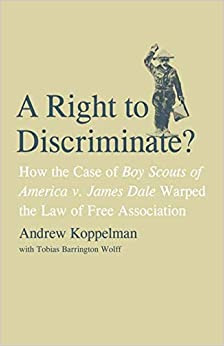
Andrew Koppelman and Tobias Barrington Wolff, A Right to Discriminate?: How the Case of Boy Scouts of America v. James Dale Warped the Law of Free Association (Yale University Press 2009)

Jack M. Balkin and Reva B. Siegel, The Constitution in 2020 (Oxford University Press 2009)
Heather K. Gerken, The Democracy Index: Why Our Election System Is Failing and How to Fix It (Princeton University Press 2009)

Mary Dudziak, Exporting American Dreams: Thurgood Marshall's African Journey (Oxford University Press 2008)

David Luban, Legal Ethics and Human Dignity (Cambridge Univ. Press 2007)

Ian Ayres, Super Crunchers: Why Thinking-By-Numbers is the New Way to be Smart (Bantam 2007)

Jack M. Balkin, James Grimmelmann, Eddan Katz, Nimrod Kozlovski, Shlomit Wagman and Tal Zarsky, eds., Cybercrime: Digital Cops in a Networked Environment (N.Y.U. Press 2007)
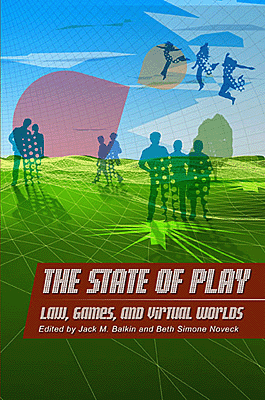
Jack M. Balkin and Beth Simone Noveck, The State of Play: Law, Games, and Virtual Worlds (N.Y.U. Press 2006)

Andrew Koppelman, Same Sex, Different States: When Same-Sex Marriages Cross State Lines (Yale University Press 2006)
Brian Tamanaha, Law as a Means to an End (Cambridge University Press 2006)
Sanford Levinson, Our Undemocratic Constitution (Oxford University Press 2006)
Mark Graber, Dred Scott and the Problem of Constitutional Evil (Cambridge University Press 2006)
Jack M. Balkin, ed., What Roe v. Wade Should Have Said (N.Y.U. Press 2005)
Sanford Levinson, ed., Torture: A Collection (Oxford University Press 2004)
Balkin.com homepage
Bibliography
Conlaw.net
Cultural Software
Writings
Opeds
The Information Society Project
BrownvBoard.com
Useful Links
Syllabi and Exams